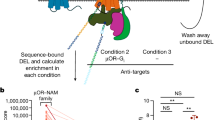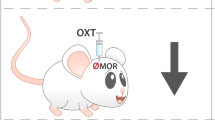Abstract
Activation of mu-opioid receptors in the nucleus accumbens (NAc) is known to increase accumbal dopamine efflux in rats. Endomorphin-2 (Tyr-Pro-Phe-Phe-NH2; EM-2) and endomorphin-1 (Tyr-Pro-Trp-Phe-NH2; EM-1) are suggested to be the endogenous ligands for the mu-opioid receptor. As the ability of EM-2 and EM-1 to alter the accumbal extracellular dopamine level has not yet been studied in freely moving rats, the present study was performed, using a microdialysis technique that allows on-line monitoring of the extracellular dopamine with a temporal resolution of 5 min. A 25 min infusion of either EM-2 or EM-1 into the NAc (5, 25, and 50 nmol) produced a dose-dependent increase of the accumbal dopamine level. The EM-2 (50 nmol)- and EM-1 (25 and 50 nmol)-induced dopamine efflux were abolished by intra-accumbal perfusion of tetrodotoxin (2 μM). Intra-accumbal perfusion of the mu-opioid receptor antagonist CTOP (D-Phe-Cys-Tyr-D-Trp-Orn-Thr-Phe-Thr-NH2; 3 nmol) failed to affect the EM-2 (50 nmol)-induced dopamine release, whereas it significantly inhibited the EM-1 (25 and 50 nmol)-induced dopamine release. The EM-1 (50 nmol)-induced accumbal dopamine efflux was significantly reduced by the systemic administration of the putative mu1-opioid receptor antagonist naloxonazine (15 mg/kg, intraperitoneally (i.p.), given 24 h before starting the perfusion). Systemic administration of the aspecific opioid receptor antagonist naloxone (1 mg/kg, i.p., given 10 or 20 min before starting the perfusion) also failed to affect the EM-2 (50 nmol)-induced dopamine efflux, whereas it significantly inhibited the EM-1 (25 and 50 nmol)-induced dopamine efflux. The present study shows that the intra-accumbal infusion of EM-2 and EM-1 increases accumbal dopamine efflux by mechanisms that fully differ. It is concluded that the effects of EM-2 are not mediated via opioid receptors in contrast to the effects of EM-1 that are mediated via mu1-opioid receptors in the NAc.
Similar content being viewed by others
Log in or create a free account to read this content
Gain free access to this article, as well as selected content from this journal and more on nature.com
or
References
Benveniste H, Hansen AJ, Ottosen NS (1989). Determination of brain interstitial concentrations by microdialysis. J Neurochem 52: 1741–1750.
Champion HC, Zadina JE, Kastin AJ, Hackler L, Ge LJ, Kadowitz PJ (1997). Endomorphin 1 and 2, endogenous ligands for the mu-opioid receptor, decrease cardiac output, and total peripheral resistance in the rat. Peptides 18: 1393–1397.
Chapman V, Diaz A, Dickenson AH (1997). Distinct inhibitory effects of spinal endomorphin-1 and endomorphin-2 on evoked dorsal horn neuronal responses in the rat. Br J Pharmacol 122: 1537–1539.
Chieng B, Connor M, Christie MJ (1996). The mu-opioid receptor antagonist D-Phe-Cys-Tyr-D-Trp-Orn-Thr-Pen-Thr-NH2 (CTOP) [but not D-Phe-Cys-Tyr-D-Trp-Arg-Thr-Pen-Thr-NH2 (CTAP)] produces a nonopioid receptor-mediated increase in K+ conductance of rat locus ceruleus neurons. Mol Pharmacol 50: 650–655.
Czapla MA, Champion HC, Zadina JE, Kastin AJ, Hackler L, Ge LJ et al (1998). Endomorphin 1 and 2, endogenous mu-opioid agonists, decrease systemic arterial pressure in the rat. Life Sci 62: PL175–179.
Das D, Rogers J, Michael-Titus AT (1994). Comparative study of the effects of mu, delta and kappa opioid agonists on 3H-dopamine uptake in rat striatum and nucleus accumbens. Neuropharmacology 33: 221–226.
Feigenbaum JJ, Howard SG (1997). Effects of naloxone on amphetamine induced striatal dopamine release in vivo: a microdialysis study. Life Sci 60: 1659–1668.
Fischer A, Undem BJ (1999). Naloxone blocks endomorphin-1 but not endomorphin-2 induced inhibition of tachykinergic contractions of guinea-pig isolated bronchus. Br J Pharmacol 127: 605–608.
Fusa K, Saigusa T, Koshikawa N, Cools AR (2002). Tyrosine-induced release of dopamine is under inhibitory control of presynaptic dopamine D2 and, probably, D3 receptors in the dorsal striatum, but not in the nucleus accumbens. Eur J Pharmacol 448: 143–150.
Fusa K, Takahashi I, Watanabe S, Aono Y, Ikeda H, Saigusa T et al (2005). The non-peptidic delta opioid receptor agonist TAN-67 enhances dopamine efflux in the nucleus accumbens of freely moving rats via a mechanism that involves both glutamate and free radicals. Neuroscience 130: 745–755.
Goldberg IE, Rossi GC, Letchworth SR, Mathis JP, Ryan-Moro J, Leventhal L et al (1998). Pharmacological characterization of endomorphin-1 and endomorphin-2 in mouse brain. J Pharmacol Exp Ther 286: 1007–1013.
Hackler L, Zadina JE, Ge L-J, Kastin AJ (1997). Isolation of relatively large amounts of endomorphin-1 and endomorphin-2 from human brain cortex. Peptides 18: 1635–1639.
Lindefors N, Amberg G, Ungerstedt U (1989). Intracerebral microdialysis: I. Experimental studies of diffusion kinetics. J Pharmacol Methods 22: 141–156.
Martin G, Nie Z, Siggins GR (1997). Mu-opioid receptors modulate NMDA receptor-mediated responses in nucleus accumbens neurons. J Neurosci 17: 11–22.
Martin-Schild S, Gerall AA, Kastin AJ, Zadina JE (1999). Differential distribution of endomorphin 1- and endomorphin 2-like immunoreactivities in the CNS of the rodent. J Comp Neurol 405: 450–471.
Mehta A, Bot G, Reisine T, Chesselet MF (2001). Endomorphin-1: induction of motor behavior and lack of receptor desensitization. J Neurosci 21: 4436–4442.
Murai T, Koshikawa N, Kanayama T, Takada K, Tomiyama K, Kobayashi M (1994). Opposite effects of midazolam and beta-carboline-3-carboxylate ethyl ester on the release of dopamine from rat nucleus accumbens measured by in vivo microdialysis. Eur J Pharmacol 261: 65–71.
Ohsawa M, Mizoguchi H, Narita M, Nagase H, Kampine JP, Tseng LF (2001). Differential antinociception induced by spinally administered endomorphin-1 and endomorphin-2 in the mouse. J Pharmacol Exp Ther 298: 592–597.
Pasternak GW, Wood PJ (1986). Multiple mu opiate receptors. Life Sci 38: 1889–1898.
Paxinos G, Watson C (1998). The Rat Brain in Sterotaxic Coordinates, 4th edn. Academic Press: New York.
Piepponen TP, Ahtee L (1995). Effects of selective opioid receptor antagonists on morphine-induced changes in striatal and limbic dopamine metabolism. Pharmacol Toxicol 77: 204–208.
Saigusa T, Fusa K, Okutsu H, Koshikawa N (2001). Monitoring of extracellular dopamine levels in the dorsal striatum and the nucleus accumbens with 5-minute on-line microdialysis in freely moving rats. J Oral Sci 43: 129–134.
Saigusa T, Takada K, Baker SC, Kumar R, Stephenson JD (1997). Dopamine efflux in the rat nucleus accumbens evoked by dopamine receptor stimulation in the entorhinal cortex is modulated by oestradiol and progesterone. Synapse 25: 37–43.
Saigusa T, Tuinstra T, Koshikawa N, Cools AR (1999). High and low responders to novelty: effects of a catecholamine synthesis inhibitor on novelty-induced changes in behavior and release of accumbal dopamine. Neuroscience 88: 1153–1163.
Sakurada S, Hayashi T, Yuhki M, Fujimura T, Murayama K, Yonezawa A et al (2002). Differential antagonism of endomorphin-1 and endomorphin-2 supraspinal antinociception by naloxonazine and 3-methylnaltrexone. Peptides 23: 895–901.
Sakurada S, Hayashi T, Yuhki M, Fujimura T, Murayama K, Yonezawa A et al (2000). Differential antagonism of endomorphin-1 and endomorphin-2 spinal antinociception by naloxonazine and 3-methoxynaltrexone. Brain Res 881: 1–8.
Sakurada S, Hayashi T, Yuhki M, Orito T, Zadina JE, Kastin AJ et al (2001). Differential antinociceptive effects induced by intrathecally administered endomorphin-1 and endomorphin-2 in the mouse. Eur J Pharmacol 427: 203–210.
Sakurada S, Zadina JE, Kastin AJ, Katsuyama S, Fujimura T, Murayama K et al (1999). Differential involvement of mu-opioid receptor subtypes in endomorphin-1- and -2-induced antinociception. Eur J Pharmacol 372: 25–30.
Schreff M, Schulz S, Wiborny D, Hollt V (1998). Immunofluorescent identification of endomorphin-2-containing nerve fibers and terminals in the rat brain and spinal cord. Neuroreport 9: 1031–1034.
Stone LS, Fairbanks CA, Laughlin TM, Nguyen HO, Bushy TM, Wessendorf MW et al (1997). Spinal analgesic actions of the new endogenous opioid peptides endomorphin-1 and -2. Neuroreport 8: 3131–3135.
Takada K, Murai T, Kanayama T, Koshikawa N (1993). Effects of midazolam and flunitrazepam on the release of dopamine from rat striatum measured by in vivo microdialysis. Br J Anaesth 70: 181–185.
Tomiyama K, Koshikawa N, Funada K, Oka K, Kobayashi M (1995). In vivo microdialysis evidence for transient dopamine release by benzazepines in rat striatum. J Neurochem 65: 2790–2795.
Tomiyama K, Noguchi M, Koshikawa N, Kobayashi M (1993). YM-09151-2 but not l-sulpiride induces transient dopamine release in rat striatum via a tetrodotoxin-insensitive mechanism. J Neurochem 60: 1690–1695.
Tseng LF, Narita M, Suganuma C, Mizoguchi H, Ohsawa M, Nagase H et al (2000). Differential antinociceptive effects of endomorphin-1 and endomorphin-2 in the mouse. J Pharmacol Exp Ther 292: 576–583.
Wang XM, Zhang KM, Long LO, Flores CA, Mokha SS (2000). Endomorphin-1 and endomorphin-2 modulate responses of trigeminal neurons evoked by N-methyl-D-aspartic acid and somatosensory stimuli. J Neurophysiol 83: 3570–3574.
Wollemann M, Benyhe S (2004). Non-opioid actions of opioid peptides. Life Sci 75: 257–270.
Yoshida Y, Koide S, Hirose N, Takada K, Tomiyama K, Koshikawa N et al (1999). Fentanyl increases dopamine release in rat nucleus accumbens: involvement of mesolimbic mu- and delta-2-opioid receptors. Neuroscience 92: 1357–1365.
Zadina JE, Hackler L, Ge L-J, Kastin AJ (1997). A potent and selective endogenous agonist for the mu-opiate receptor. Nature 386: 499–502.
Acknowledgements
This study was supported by Research Grants from the Sato Fund (TS, NK) and Dental Research Centre (NK), Nihon University School of Dentistry; Nihon University Multidisciplinary Research Grant for 2005/2006 (TS, NK, ARC); a grant for promotion of multidisciplinary research project (NK, ARC) and a grant-in-aid for scientific research (# 14 370 609 to NK and # 16 591 897 to TS) from the Ministry of Education, Culture, Sports, Science, and Technology, Japan; and The Promotion and Mutual Aid Corporation for Private School of Japan (SW, IT, YA, NK).
Author information
Authors and Affiliations
Corresponding author
Rights and permissions
About this article
Cite this article
Okutsu, H., Watanabe, S., Takahashi, I. et al. Endomorphin-2 and Endomorphin-1 Promote the Extracellular Amount of Accumbal Dopamine via Nonopioid and Mu-Opioid Receptors, Respectively. Neuropsychopharmacol 31, 375–383 (2006). https://doi.org/10.1038/sj.npp.1300804
Received:
Revised:
Accepted:
Published:
Issue date:
DOI: https://doi.org/10.1038/sj.npp.1300804
Keywords
This article is cited by
-
Integrative opioid-GABAergic neuronal mechanisms regulating dopamine efflux in the nucleus accumbens of freely moving animals
Pharmacological Reports (2021)
-
Pseudoginsenoside-F11 inhibits methamphetamine-induced behaviors by regulating dopaminergic and GABAergic neurons in the nucleus accumbens
Psychopharmacology (2016)
-
Role of alpha adrenoceptors in the nucleus accumbens in the control of accumbal noradrenaline efflux: a microdialysis study with freely moving rats
Journal of Neural Transmission (2007)



